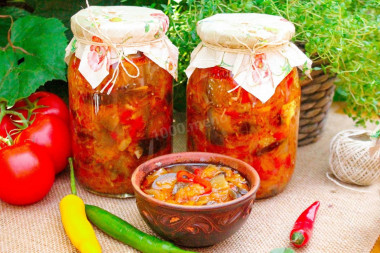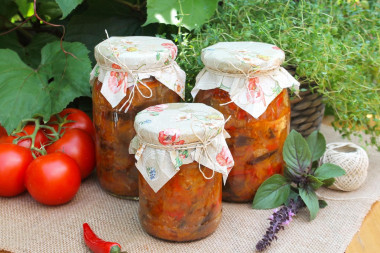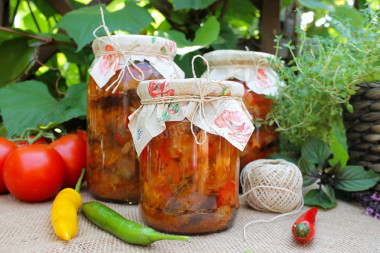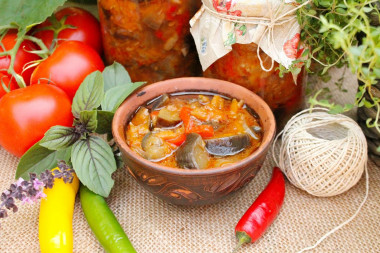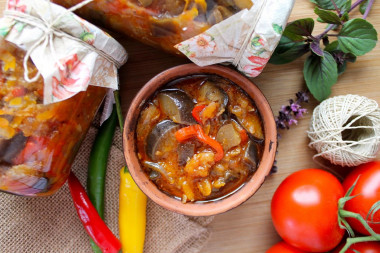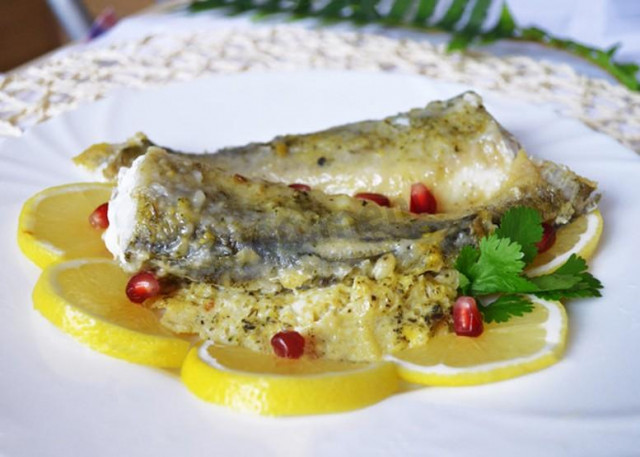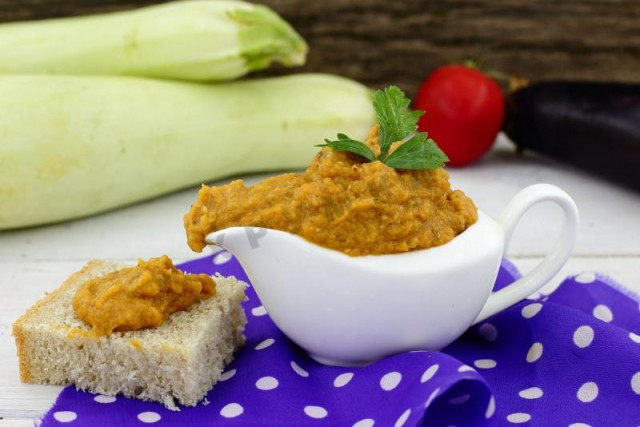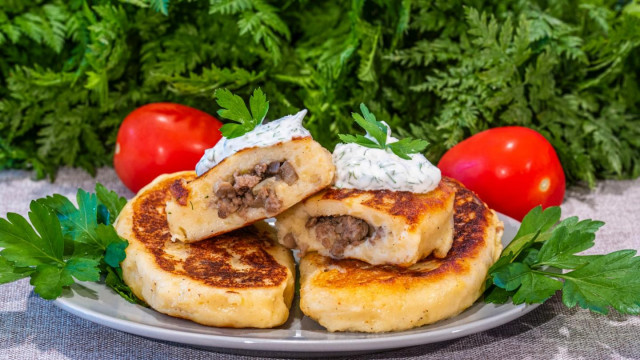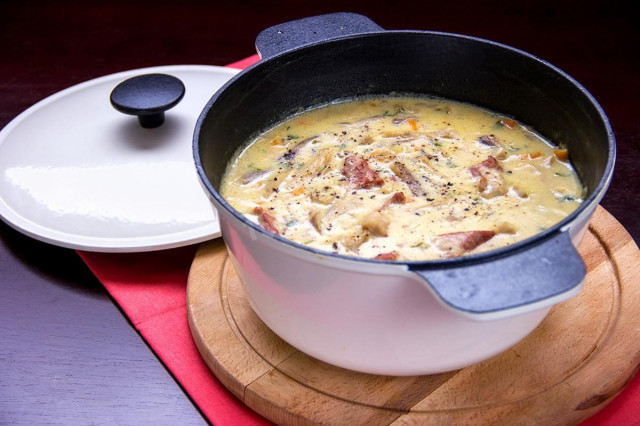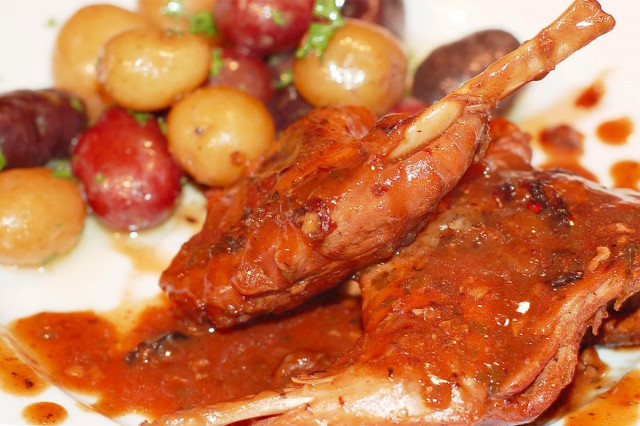Composition / ingredients
Step-by-step cooking
Step 1:
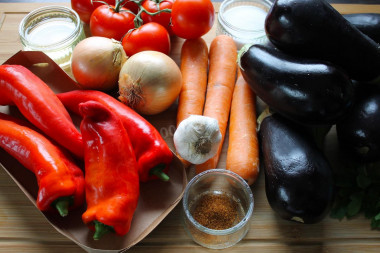
How to make eggplant and pepper lecho with tomatoes for the winter? Prepare all ingredients. Especially tasty preparation for the winter is obtained from seasonal vegetables. Wash all the vegetables well beforehand and dry them.
Step 2:

Peel the tomatoes. To do this, make a cross-shaped incision on each tomato, as in the photo.
Step 3:

Pour boiling water over the tomatoes and leave this way for two to three minutes.
Step 4:

Next, put the tomatoes in cold water. From a sharp temperature drop, it will be possible to easily and effortlessly remove the skin.
Step 5:
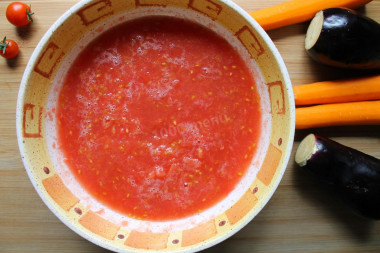
Put the tomatoes through a meat grinder or chop them with a blender. If you do not have a blender or a meat grinder, then you can use a large grater (in this case, it is not necessary to remove the peel, cut each tomato into 2 parts and grate it).
Step 6:
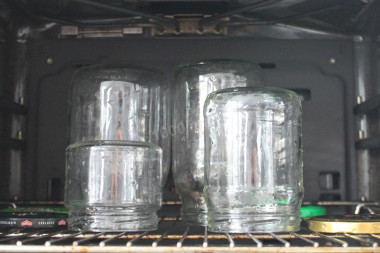
Sterilize the jars and lids in any way convenient for you. I usually sterilize in the oven, put clean lids and jars in a cold oven, set the temperature to 180-190 degrees and leave for 20-30 minutes.
Step 7:

Peel the carrots, onions and garlic, cut off the tails from the eggplants. Rinse all the vegetables under cold running water.
Step 8:
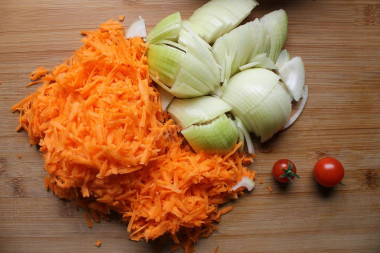
Grate the carrots on a coarse grater, and cut the bulbs into thin half rings.
Step 9:
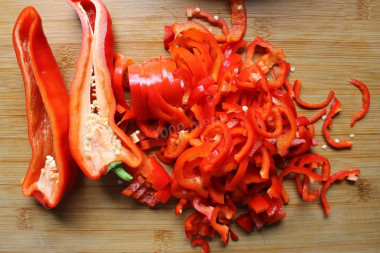
Cut the bell pepper in half, remove the core with seeds and stems. Cut each pod into half rings.
Step 10:
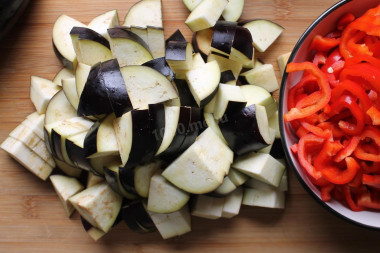
Cut the eggplant into small cubes or medium-sized pieces, as in the photo. You can peel the eggplant beforehand (I don't do that).
Step 11:
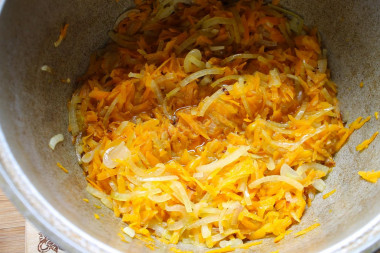
Pour vegetable oil into a cauldron or into a large frying pan, put on medium heat and wait for the oil to heat up. I prefer to cook lecho in a cauldron, it seems to me that eggplants turn out richer and tastier. Send the carrots and onions to fry, turn down the heat. Stir the vegetables periodically so that they do not burn, cook in this way for about 7 minutes.
Step 12:

Send eggplants, bell peppers and tomatoes to the cauldron.
Step 13:
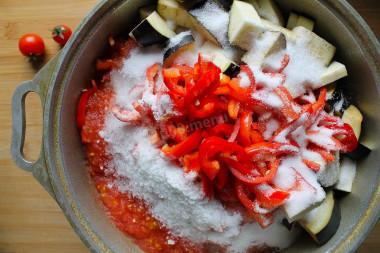
Then add salt and sugar.
Step 14:
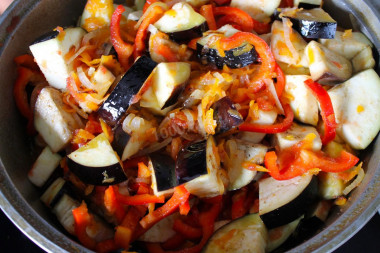
Mix everything carefully, wait for the moment of boiling. Reduce the heat to low and simmer the vegetables for about 30 minutes (important! Lecho should constantly boil slightly, if this does not happen, then add fire under the cauldron).
Step 15:

Add pre-chopped garlic to the lecho. It can be grated on a fine grater, or passed through a press. If you don't like the taste of garlic in the finished dish, exclude it altogether. Add vinegar and mix everything well. Simmer for about 10 more minutes. Taste the eggplant, check if there is enough salt, sugar and vinegar. If some component is missing, then add it to your liking.
Step 16:

Put the finished lecho into sterile jars and roll up with sterile lids.
Step 17:
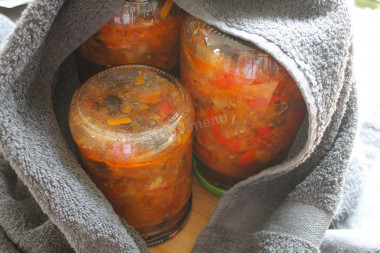
Turn the workpiece upside down and wrap it with a towel or a warm blanket. Leave it to cool completely at room temperature, then put it in the cellar or in the refrigerator on the bottom shelf for long-term storage.
Step 18:
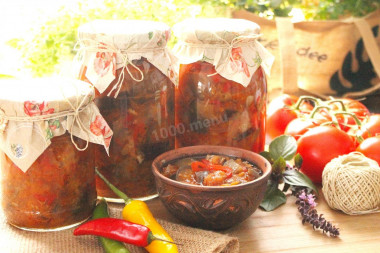
A wonderful and very tasty snack is ready!
About 2.7 liters of the finished product comes out of the specified number of components (depends on the juiciness and variety of tomatoes, whether you use fleshy peppers and how much you evaporate the liquid at the end of cooking). I got 2 liters, one 700 gram (and three to five spoons left for the sample).
Adjust vinegar, salt and sugar to your liking. The composition, which is indicated in the recipe, I liked 100% - neither reduce nor add.
If you like spicy salads, then add chili pepper in step 12 or ground hot pepper in step 15.
If desired, add finely chopped greens such as dill, parsley or cilantro to the finished lecho. Send fresh herbs to the cauldron along with garlic and let it boil for 10 minutes. The greens will give a special touch to the finished salad.
If at the end of cooking you got too liquid lecho (and this largely depends on the variety and juiciness of tomatoes), then make the fire under the cauldron to the maximum and evaporate the right amount of liquid, stirring the lecho periodically. You can also use a little more eggplant and less tomatoes initially.
Bon appetit!
How to calculate the number of cans, why banks explode and how to avoid it, as well as secrets and life hacks, read the article about preparations for the winter.
Use oil with a high smoking temperature for frying! Any oils are useful only until a certain temperature is reached - the point of smoking, at which the oil begins to burn and toxic substances, including carcinogens, are formed in it.
Unrefined oils, with rare exceptions, have a low smoking point. There are a lot of unfiltered organic particles in them, which quickly begin to burn.
Refined oils are more resistant to heating, and their smoking point is higher. If you are going to cook food in the oven, on a frying pan or grill, make sure that you use oil with a high smoking point. The most common of the oils with a high smoking point: refined varieties of sunflower, olive and grape.
If you are new to canning, have little experience in home preparations, it is better to be safe and
sterilize cans of vegetables, even if the recipe says the opposite
. This guarantees you that the banks will not swell during storage if you did something wrong, did not report something/shifted or violated the technology.
Remember that banks swell more often for the only reason:
excess gases are formed in them
. And those, in turn, appear because
they are isolated by microorganisms trapped in the workpiece
.
Anyway,
the swelling of the cans has nothing to do with the quality of the recipe, which has already been successfully prepared.
Caloric content of the products possible in the composition of the dish
- Onion - 41 kcal/100g
- Tomatoes - 23 kcal/100g
- Sweet pepper - 27 kcal/100g
- Carrots - 33 kcal/100g
- Dried carrots - 275 kcal/100g
- Boiled carrots - 25 kcal/100g
- Eggplant - 24 kcal/100g
- Garlic - 143 kcal/100g
- Granulated sugar - 398 kcal/100g
- Sugar - 398 kcal/100g
- Wine vinegar (3%) - 9 kcal/100g
- Vinegar 9% - 11 kcal/100g
- Balsamic vinegar - 88 kcal/100g
- Apple vinegar - 14 kcal/100g
- Vinegar - 11 kcal/100g
- Vegetable oil - 873 kcal/100g
- Salt - 0 kcal/100g


